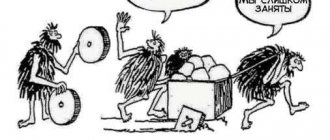In this note, I want to share my experience on what to do if an employee comes to work drunk, because such behavior “happens” to people.
And as you yourself understand, the appearance of an employee at work while intoxicated can be a source of increased danger, leading to casualties and injuries.
And the first question that arises in this situation for the employer is “a drunk employee in the workplace, what to do according to the law?”
So as not to be an extreme case in this situation, because simply sending him home to sleep and saving others, himself and him from a bad set of circumstances, and employee gratitude are two different things.
Because if something happens that affects his personal interests, even despite the fact that he is wrong, he can also write a complaint that he wasn’t drunk, but you treated him so badly... you didn’t allow him to work , kicked out, fired, or not everyone was paid... and so on and so forth, in general, situations are different!
Where do we start?
Suspension from work in the organization is formalized by order. But in order for it to be valid, there must be appropriate grounds for its publication. The document that initiates the removal procedure may be a memorandum addressed to the head of the organization. It is compiled by the employee’s immediate supervisor or any other employee who notices signs of intoxication in his colleague. It must indicate the date, time of compilation, and signs indicating that the employee is intoxicated. The memorandum is registered in the organization's internal records journal and filed in the employee's personal file.
Next, it is recommended to ask the employee for an explanation. In the explanatory note, the employee must justify the fact of appearing at work in such a state. It is clear that when intoxicated, an employee may not be able to adequately explain himself, but, on the contrary, uncontrolled handwriting and an incoherent style of expressing thoughts may be further confirmation of the employee’s corresponding state. In the future, the explanatory note can be used by the employer to resolve the issue of applying a disciplinary sanction to the employee. If an employee refuses to give an explanation, this must be recorded in a Certificate of Refusal to Give Explanations.
Showing up at work drunk after hours
From a legal point of view, an employee appearing drunk at a non-working place can only be considered an administrative offense in accordance with Art. 20.21 Code of Administrative Offenses of the Russian Federation. The employer should limit itself to calling the police.
In addition, labor legislation provides that the basis for dismissal is the appearance at the workplace of an employee performing a labor function. During non-working hours, the employee does not perform labor functions and cannot be fired for this.
We draw up a report on the employee being in a state of intoxication at the workplace
In order to document that an employee is intoxicated at work, it is necessary, in the presence of at least two witnesses, to draw up a Report on the employee appearing at the workplace in a state of intoxication. The compiler can be either the employee’s immediate supervisor or an employee of the organization’s human resources department. Despite the fact that the form of the act is not fixed by law, in order for it to be regarded as a basis for removing an employee from work, it must indicate:
- date, exact time of its compilation;
- place of compilation;
- surname, name, patronymic of the compiler and those present;
- time of detection of an intoxicated employee;
- an indication of the presence of an intoxicated employee when drawing up the report;
- the state of the employee, indicating the signs by which one can draw a conclusion about the state of intoxication;
- an indication of familiarization with the act of an employee who is in a state of intoxication, his signature, date, or an indication of familiarization with the act of an employee who is in a state of intoxication and refuses to sign for familiarization with the said act;
- signatures of the author of the act and those present.
Very important information in this act will be an indication of the signs confirming the fact of intoxication. If we talk about alcohol intoxication, then this is incoherent speech, the smell of alcohol in the exhaled air, an unsteady gait, lethargy/excessive agitation, and inconsistency of behavior with social norms. If the latter is observed, then it is necessary to specifically describe what this discrepancy is. The more detailed the employee’s condition is described, the better, since the act essentially records the testimony of those present. The employee must be familiarized with the Certificate against signature. If this is impossible to do due to the fact that the employee is not able to understand what they want from him, the following entry should be made in the act: “A. A. Ivanov does not understand the questions addressed to him and the meaning of his actions, due to which is why it is not possible to familiarize him with this act on the day of drawing up.” This entry is also signed by the compiler and those present. If the employee deliberately refuses to familiarize himself, a corresponding entry about this is made in the act, also signed by all those present.
We send the employee for a medical examination
In order to completely confirm or refute the fact of intoxication, it is necessary to send the employee for a medical examination. He has the right to be taken to a medical institution that has the appropriate license, equipment and personnel with appropriate qualifications. The examination is carried out at the expense of the employer, but if the fact of intoxication is established, the employer will have the right to recover these expenses from the employee. Delivery to a medical institution is accompanied by a responsible person from the employer. Upon completion of the examination, the medical institution issues a medical report in two copies: one to the employee, the second to the accompanying person from the employer.
According to generally accepted conditions, the medical report will reflect one of the following conditions:
- sober, no signs of alcohol consumption were detected;
- the fact of alcohol consumption was established, signs of intoxication were not identified;
- alcohol intoxication;
- alcoholic coma;
- state of intoxication caused by narcotic or other substances;
- sober, there are functional impairments that require removal from work with a source of increased danger for health reasons.
If it is proven that there was consumption, but no signs of intoxication were detected, the employer does not have the right to remove the employee from work.
However, it is worth noting that the employer does not have the right to force the employee to undergo a medical examination, and the employee has every right to refuse it. In this situation, it is imperative to record this fact by drawing up a Certificate of Refusal of Medical Examination, an example of which you will also find in the appendix to the article.
Is it possible to challenge dismissal and return to work?
If an employee who was fired for being drunk at work does not agree with the fact of dismissal, he can file a claim with the court or the labor inspectorate. At the same time, he must be ready to prove his innocence and the illegality of his dismissal.
The trial is underway...
The following may be presented as evidence:
- witness statements, surveillance camera footage confirming that the employee was sober;
- testimony of the attending physician, prescription for medicine, medical report (if the apparent intoxication was caused by taking alcohol-containing drugs or a health condition);
- analysis of documents submitted by the employer, indicating inaccuracies or violations in design or substance.
The most effective way to prove the employer wrong is to agree to undergo a medical examination and obtain a conclusion that there is no alcohol in the blood.
Having sufficient evidence, an employee can not only convince the court that he is right, but also present his demands to the employer, for example:
- about returning to work with retention of position and salary;
- on full payment for the entire period of proceedings during which the employee did not receive wages;
- on compensation for moral damage.
If there is evidence presented, the court quite often satisfies the employee’s demands in full.
Order of suspension
After the employer has received a conclusion with the results of a medical examination from a medical institution or, in its absence, after drawing up a Certificate of the employee being at work, it is necessary to issue an Order on suspension from work and familiarize the employee with it against signature. The order specifies the basis for the suspension, as well as the period for which the employee will not be allowed to perform official duties. As a rule, the period of suspension in case of alcohol intoxication is 1 working day.
The order must contain a note indicating that the employee has familiarized himself with it. In case of refusal to familiarize yourself, you must draw up a Certificate of refusal to familiarize yourself with the order (6) or make a note in the order itself. As a general rule, the act is drawn up in the presence of 2 more employees of the organization, not counting the drafter.
After the end of the suspension period, the employer issues an Order on admission to work , which the employee is also familiarized with accordingly.
A small guide to action
For example, a drunk security guard showed up to work. The employer must take the following measures:
- record alcohol intoxication in the workplace by drawing up a document (an act, for example) listing the signs of intoxication;
- a separate inspection report records drinking alcohol directly at work;
- create a commission that will investigate what happened;
- based on the results of the commission’s work, it must draw up a report on the employee’s appearance in a state of intoxication (in free form);
- suspend the employee from work;
- resolve the issue of disciplinary punishment.
If the employer wishes to bring the offending employee to disciplinary liability, he will need:
- provide the employee with the opportunity to give written explanations;
- if after two days no explanation is received, then an act of refusal (evasion) from giving an explanation is drawn up;
- bring to the attention of the employee the order (instruction) on disciplinary action no later than three working days from the date of its publication.
If management intends to maintain the employment relationship, then an order is issued to allow the employee to work.
An employee can be fired not only for being intoxicated at the workplace, but also on the territory of an enterprise or facility where he is carrying out instructions from the employer during working hours.
Once, an employer fired his employee because the latter traveled home from his shift by train by train while intoxicated. The court considered this management decision illegal, since the days spent traveling to and from work are not counted as working hours. In fact, being in transport was a period of inter-shift rest.
Question: What if an employee shows up drunk on business premises after hours?
Here the courts have a different approach. Some believe that the employer has the right to punish a subordinate for this. Others believe that Article 81 of the Labor Code of the Russian Federation for alcohol intoxication is not applicable here. Meanwhile, the second position seems correct, since it is based on labor legislation.
For example , a worker came into the factory after hours after drinking. The internal labor regulations stipulated that management can punish the offender if he appears drunk both during working hours and during rest. The regional court, when reviewing the lower decision, agreed with the employer’s decision and the legality of the disciplinary sanction.
The situation is different if the work schedule has changed.
For example , a citizen was fired for showing up at work while intoxicated. During a pre-trip inspection, he was found to have ppm. In court, he indicated that he went to work on his day off. Meanwhile, the employer argued its position by saying that the schedule for changing the schedule was communicated to the dismissed employee in advance. The court considered that the employee actually began to perform his duties: he showed up at the appointed time, received a waybill, and underwent a pre-trip medical examination. As a result, the dismissal was declared legal.
Responsibility
Appearing at work in a state of intoxication is a gross violation of labor discipline on the part of the employee, and even committed once is sufficient grounds for dismissal of the employee (clause “b”, paragraph 6 of part one of Article 81 of the Labor Code of the Russian Federation). If the employer plans to resort to this measure, he needs to be especially careful when drawing up documents and following the entire procedure and not neglect the medical examination. If the court finds that the employer did not provide sufficient evidence of the fact that the employee was intoxicated, the dismissal will be declared illegal, and the employer will be obliged to reinstate the employee at work, pay him for forced absence in the amount of average earnings and compensate for moral damage. For illegal deprivation of an employee's right to work, administrative liability may also be applied to the employer and its officials (according to Article 5.27 of the Code of Administrative Offenses of the Russian Federation).
In conclusion, I would like to note that compliance with the removal procedure and proper execution of documents will help mitigate the above risks and establish labor discipline in the organization.
comments powered by HyperComments
Share news:
The entry was published on September 28, 2015 by Alexandra Semakova in the category Organization of labor protection work.
How to fire - step by step instructions
If the employer has decided to apply sanctions and fire an unscrupulous employee for drunkenness, a number of nuances will need to be taken into account. The entire step-by-step procedure is strictly regulated by Art. 81 of the Labor Code of the Russian Federation and does not allow simply terminating an employment contract.
How to determine if an employee is drunk
The fact that an employee has consumed alcoholic beverages can be determined by indirect evidence. Even a small amount of alcohol is enough for the management of the enterprise to be able to recognize a state of intoxication.
Signs of intoxication:
- noticeable odor of alcohol;
- noticeable dilation of the pupils;
- atypical lack of coordination;
- confusion of speech;
- redness of the facial skin;
- problems with performing duties.
With severe intoxication, the situation becomes more obvious. A drunk employee may begin to behave inappropriately or be very lethargic.
Evidence of alcohol intoxication and recording of violations
If an employee shows signs of intoxication, the employer will need to collect evidence and record the violation in order to be able to officially record the reason for dismissal. They may also be needed if the employee decides to challenge the decision in court.
Evidence may include testimony from management, colleagues and other witnesses, memos with reports or reports. It is important that all of them are not contradictory and allow one to draw an unambiguous conclusion about the employee’s condition. Video recordings from surveillance cameras installed at the enterprise can also be confirmed.
To record a violation, you will need to draw up an appropriate act. It can be filled out in any form, but must reflect all the basic information:
- Full name of the offender, his position;
- information about who revealed the fact of intoxication;
- detected signs of intoxication;
- the employee’s consent or refusal to undergo a medical examination;
- information about witnesses.
You also need to remember that by this time an order for removal should already be prepared. Information about it should also be indicated in the act.
Medical examination
The employer must offer the offender to undergo a medical examination to determine the amount of alcohol in the blood. If he agrees, then he is given a free-form referral to any licensed clinic. Specialists conduct an examination, examine the exhaled air using a breathalyzer and conduct a urine test.
After passing the medical examination, the employee receives a certificate provided for in Appendix No. 2 to Order No. 933n of the Ministry of Health. It indicates the amount of alcohol detected and provides recommendations for removing the person from work until he sobers up.
According to paragraph 42 of Resolution No. 2, enshrined by the Plenum of the Armed Forces of the Russian Federation, the employer is not required to conduct a medical examination of an employee upon dismissal for drunkenness. Instead, he may use other evidence. However, the presence of an appropriate act will significantly facilitate the situation if the dismissed person goes to court.
Reference! Most often, employees who show up to work drunk refuse to undergo a medical examination. Under such circumstances, the employer does not have the right to force subordinates to the procedure and exert any pressure on them.
Explanatory note from an employee
Based on the law, namely Art. 81 and art. 192 of the Labor Code of the Russian Federation, dismissal for drunkenness at work is considered disciplinary punishment. Therefore, before imposing it, the employer must receive an explanatory statement in writing from the violator.
If an employee refuses to comply with the requirements, management draws up a corresponding act. It must also be signed by 3 witnesses. Before filling it out, you need to wait 2 days allotted to the violator to write an explanatory note.
What documents are drawn up
When dismissing an employee under this article, you will need to issue an appropriate order, supported by evidence. It must be given to the person being dismissed for review. If he refuses, then he will have to draw up an act with 3 witnesses. Information about the order must be entered into the personnel registration log.
If there is a trade union at the enterprise, then management is obliged to take its opinion into account before making a decision on dismissal. This is regulated by Art. 373 Labor Code of the Russian Federation.
Sample dismissal order under article:
On the last working day, information about the reason for dismissal is entered into the work book and confirmed with a seal. If the decision is later found to be invalid, the entry will be cancelled.
Are payments due?
If an employee was fired under an article, then severance pay is not paid to him. However, the employer is still obliged to pay the rest of the salary, compensation for unused vacation days and sick leave if it was opened within a month from the date of dismissal.
The company may also incur additional liability. This is possible if management has not suspended the offender from work. Then it undertakes to pay compensation for property damage or injury. And the person who was supposed to carry out the suspension may be held accountable for violating labor safety rules.









